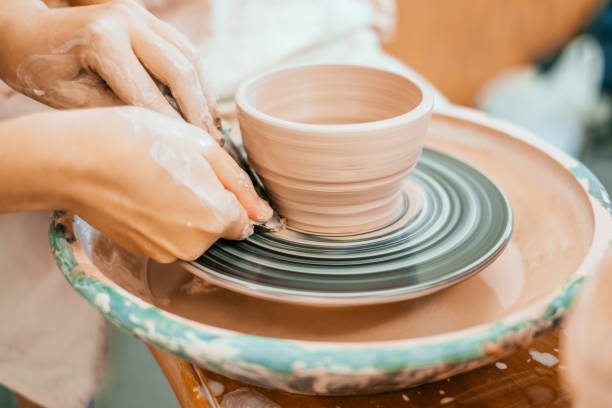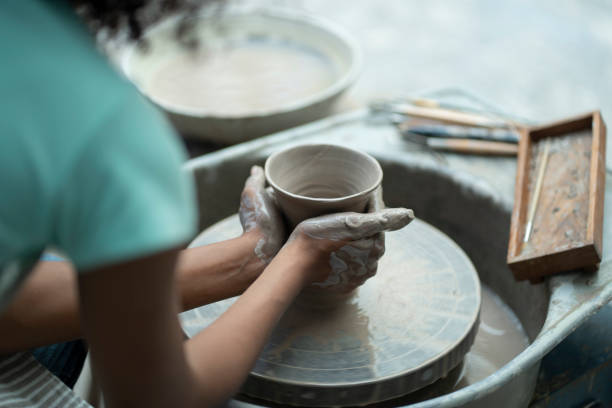Fritted glazes have a more uniform chemistry than those made from raw materials. This allows for more predictable chemistries that can be scaled up for large projects (see the melt fluidity tests of this and a normal cone 6 glaze below).
Frits encapsulate otherwise water-soluble flux elements and, in some cases, boron. They are also less volatile than raw materials (like lithium or barium carbonates) which contaminate glaze slurries with toxic compounds.

What is a frit?
In glazing, ceramic frit is an ingredient used to make glass surfaces more durable and resistant to thermal shock. Ceramic frit is available in a wide range of colors, thicknesses, and surface finishes to meet the needs of different building types. It is typically applied with a large roller for full spandrel applications or through a screen for silk-screen applications. It can be affixed to glass for decorative/aesthetic appearances or for functionality such as solar control.
A frit is a ground glass that has been premixed from raw powdered minerals, melted, cooled by quenching in water, and then ground into a fine powder. It is a major ingredient in glazes and serves several purposes: It encapsulates otherwise water-soluble flux elements; it improves the fluidity of a glaze by adding silica; it can brighten or mute added colorants; and it adds stability, strength, and durability to fired glazes. It is also a source of oxides.
It seems logical that the kiln doesn’t care where the oxides come from, so long as they are there. The chemistry is the same, whether you get the oxides from feldspar or zircon, for example. However, the fact is that frits melt more readily than crystalline raw materials and they soften over a range of temperatures, instead of melting suddenly as does a feldspar.
Frits are man-made glass powders
Frits are formulated to melt quickly and evenly after body gases have been expelled, which reduces glaze imperfections and firing issues (like pinholes, blisters, orange peeling, crazing). The chemistry of frit is also controlled, making it possible to create chemistry that would not be possible with raw materials. This results in matteness, opacity, specific mechanical properties, and color response that cannot be produced with raw materials alone. You can get this at a pottery store near you.
The use of frits allows for a more precise control of the oxides that are added to the glaze slurry. This is important because it makes it easier to make a glaze with desired characteristics, while still achieving the best possible results. For example, the use of a high-MgO frit can allow for high strontium and barium glazes without chemistry problems that are normally encountered with these oxides in raw form.
It is a great idea to try out several different frits side by side, as each will have a slightly different chemistry, melting point, fluidity, etc. It is a good way to see how they compare in terms of fired results and can help you determine what type(s) of frit you will want to add to your glaze recipe moving forward. The ability to do this easily with a few slurry tests will save you time and money in the long run, especially when you are working with limited quantities of raw materials.

Frits are a source of oxides
The chemistry of frits allows you to source oxides in your glazes that are difficult to source from raw materials (e.g. Li2O, BaO, ZnO and SrO). The kiln does not care if the oxides come from feldspar or a frit but the resulting glaze chemistries are quite different.
In addition to allowing you to add difficult to source oxides frits have other useful properties. For example, they lower the melting temperature of glazes and bodies making them easier to fire and more predictable. They also reduce the occurrence of glaze defects, like bubbles, crystallization and devitrification. They also have low drying shrinkage, are a good flux and allow for more opacity in glazes.
While a little bit of a mystery to smaller operations and potters that use raw glazes, learning about and using frits can solve many problems, improve processes and create better products. They make the difference between firing a ceramic at a high or low temperature, between being crystalline or glassy and having a rapid or slow melt. They can also be used to make a glaze plastic or more viscous, for adjusting the thermal expansion and to modify its color and surface texture. They also allow for the control of opacity and matteness. Most importantly, they are consistent and provide precise chemistries. For this reason they are used in industrial ceramics, ceramic tile, glass and pottery production.
Frits are a source of boron
Frits are a valuable ingredient in the ceramic production process because they provide a consistent source of oxides that can be used to create glazes. They are manufactured from high-purity raw materials and are melted at high temperatures, then quenched in water to form a friable mass. These are then ground and screened to remove any insoluble components. The resulting products are much more consistent than raw materials, and they can be used to create glazes with specific physical characteristics such as opacity, fluidity, transparency, and stiffness. They also eliminate the risk of dangerous materials, such as lead and barium, being present in the finished product.
Another benefit of frit is that it can be a good substitute for some mineral raw materials in glazes. This is because some of these minerals contain undesirable or unsafe compounds that may be leached from unfired glazes, while frits have no such issues. In addition, frits can be used to make glaze formulas that would not be possible with raw materials because they are less volatile and have a lower LOI.
When comparing glazes made with frit to those using a similar mineral raw material (in this case feldspar), the differences can be quite dramatic. For example, a common cone 6 recipe sources both Na and MgO with feldspar, which melts early on in the melting cycle, and MgO from talc, which is not active until well past 1800F. However, a common frit can source the MgO in this glaze by itself because it is active at a lower temperature range.
Tags: Pottery supplies



